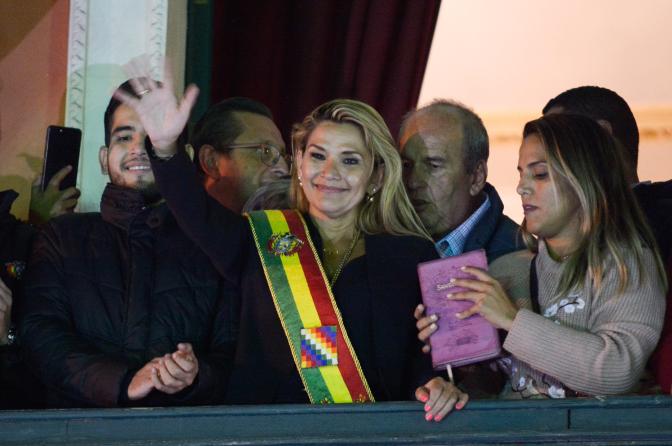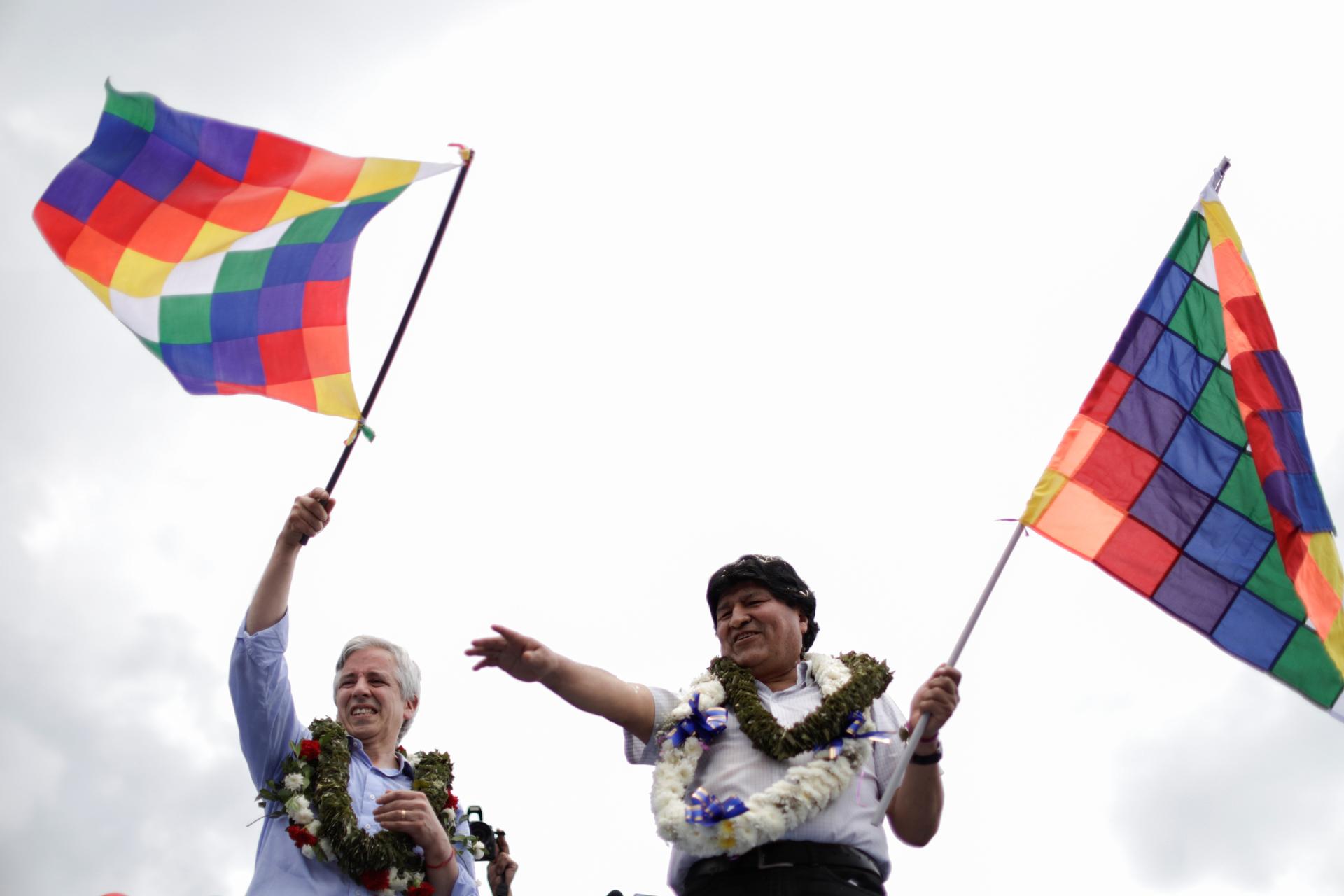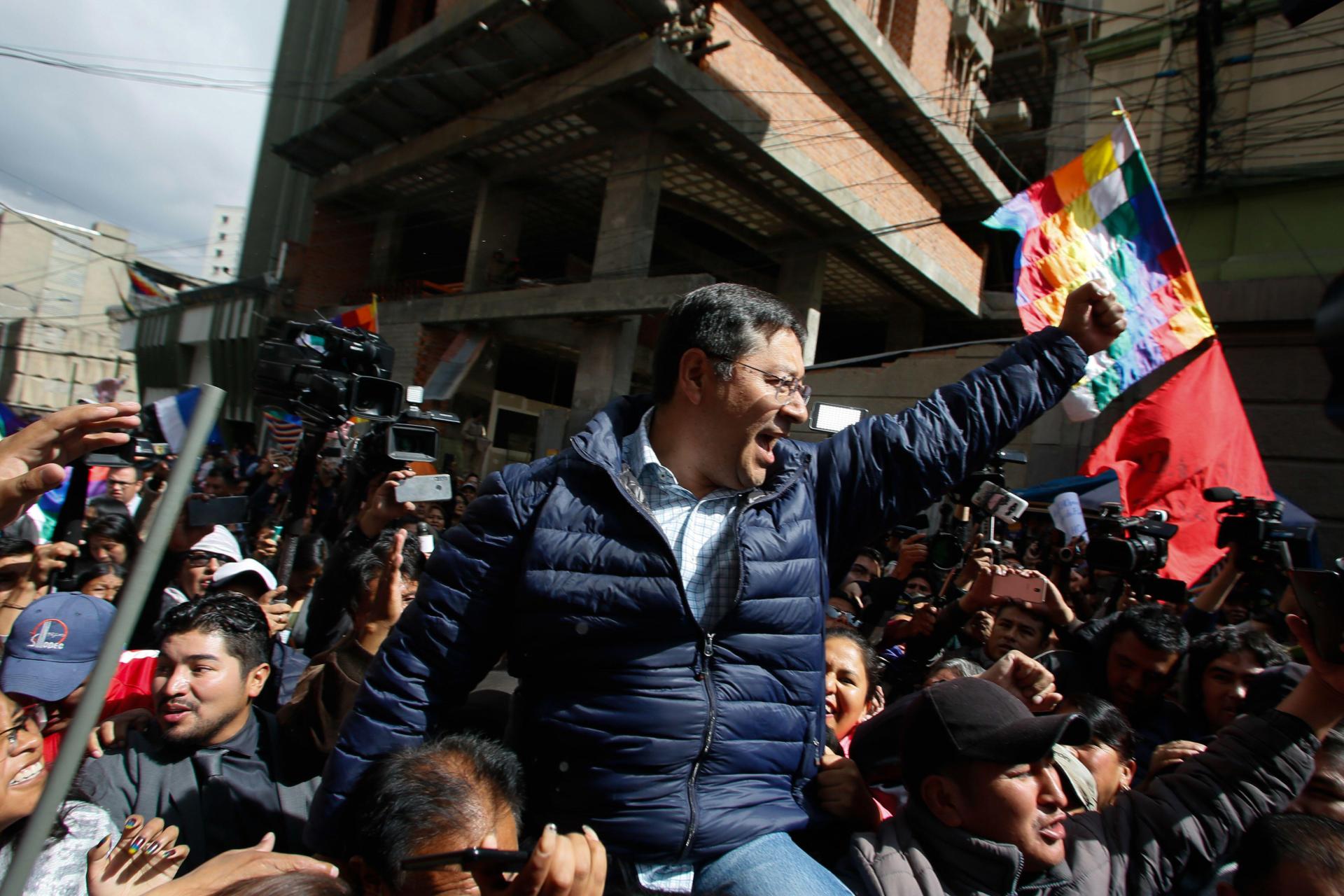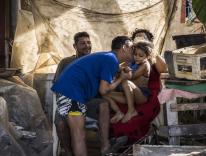After a tumultuous year in Bolivia, the socialists are back in power. “We have recovered democracy and...hope,” announced the Bolivian president-elect Luis Arce as he claimed victory in last October’s presidential election. The turnout was high, and various international watchdog groups declared the election fair. Arce, the presidential candidate for the Movement for Socialism party (MAS), defeated his closest rival, Carlos Mesa, decisively—55 to 29 percent. It was a peaceful end to Bolivia’s slow slide toward the abyss. In the months leading up to the election, the country had come close to dictatorship and civil war.
A new Bolivian president should have been elected a year earlier. But the results of the October 2019 election were annulled after observers from the Organization of American States (OAS), seconded by the European Union, claimed to have found significant irregularities in the vote tallies. On election night, vote counting was suddenly suspended for twenty-four hours, after which the lead of the incumbent candidate, the socialist Evo Morales, increased from 7 percent to 10 percent—the exact margin required to avoid a runoff. At first, Morales, who had been president of Bolivia since 2006, contested the findings of the OAS and the EU. A popular and outspoken indigenous leader, he had been favored to win a fourth term, but the allegations of electoral fraud sparked mass protests against his government.
By November 10, 2019, following weeks of protests and bloody clashes, and under pressure from the military, Morales resigned along with his vice president, Álvaro García Linera. Morales fled to Mexico. After more resignations, the rules of succession delivered the presidency to Jeanine Áñez, a senator from the right-wing Democrat Social Movement, which had obtained only 4 percent of the vote in the election. Áñez’s official title was “interim president”; her term was to last only until new elections scheduled for May 2020. During that time, Morales’s party retained its two-thirds majority over both houses of parliament.

Áñez often behaved more like a despot than a caretaker president. When she assumed power on November 13, she did so in dramatic fashion, holding a Bible above her head as she entered the presidential palace. In the eyes of Áñez and many in the right-wing opposition, Morales’s party is associated with an allegedly non-biblical form of indigenous Catholicism and the purported godlessness of First World leftists. Days before Áñez took office, police officers had engaged in a bizarre ceremony where the whipala—a flag representing various indigenous peoples, and since 2009 the alternate flag of Bolivia—was stolen from the presidential palace and trampled on. A video showing a policeman cutting the embroidered image of the whipala from his uniform went viral. Knowing that this vandalism had been perpetrated by some of his followers, the right-wing politician Luis Fernando Camacho urged them to “respect those who feel represented by this flag.” But the damage had been done, and protestors in La Paz warned of a coming civil war.
Áñez’s offenses went beyond the symbolic. Days after she assumed the presidency, the military opened fire against demonstrators, killing eight people in Sacaba and nine in Senkata. In the wake of these massacres, Áñez tried to grant security forces blanket immunity—a measure overturned after international outcry. Later, she postponed the May elections, citing the pandemic. But this rationale became less convincing when she tried to postpone the elections a second time.
Finally, however, the elections were held on schedule in October—though only after MAS staged mass protests. These included seventy highway blockades, which were denounced by some as immoral because they blocked crucial medical supply lines during a pandemic. MAS said the blockades were the only way for them to assert themselves against a burgeoning tyranny. For most of Morales’s supporters, the events of November 2019 amounted to a coup d’état led by Morales’s enemies and supported by a corrupt OAS.
“I love Bernie Sanders. I am of the Left. But Sanders was wrong,” Fernanda Wanderley, director of the Institute for Socioeconomic Studies of the Catholic University in La Paz, told me. Wanderley was referring to Sanders’s November 2019 statement in support of Morales, which employed the charged word “coup” to describe his fall from power. This statement led some journalists to accuse Sanders (unfairly) of defending a “dictator.” In the United States, the dominant media narrative cast Morales as a left-wing populist who accomplished many good things but also threatened democratic norms and therefore deserved to be forced out of office. But a vocal minority, Sanders among them, held that Morales had been the victim of another U.S.-backed coup in Latin America.
In a coup, a minority power seizes control of the government, overturns the constitutional order, and suspends democracy. Whether one believes that what happened in Bolivia counts as a coup hinges on how much one trusts the OAS observers who declared the 2019 election fraudulent. Hours before stepping down, Morales tried to negotiate with the OAS, offering to redo the elections. Later, two MIT-based researchers would publish a widely publicized analysis critical of the OAS’s fraud allegations. (Last June, the OAS published a rebuttal.)
The OAS aims to be for the Western hemisphere something like what the United Nations is for the whole world, but left-wing parties have long considered it a tool of U.S. imperialism. They are especially suspicious of the current OAS president, Luis Almagro. Yet the Inter-American Commission on Human Rights, an autonomous organization within the OAS, did officially condemn the Áñez government’s response to the protests in Sacaba and Senkata as “massacres.” And when Almagro visited Bolivia in May 2019, he said he was not opposed to Morales’s running for a fourth term.
What Morales’s supporters call a “coup” Wanderley describes as a popular revolt against a once-democratic government that was turning into a tyranny. “I do not use the word ‘coup.’ What I see is that Bolivia has a long history of mobilizations and a great tradition of street politics. And so, mobilizations in the streets are not exceptional events. On the contrary, they are part of the Bolivian political tradition.... I was not surprised to see mobilizations [against Morales] in 2019. The event that is most similar to the events of 2019 is what happened in 2003.” During the 2003 “Gas War,” security forces eventually stood down before organized protests against the privatization of natural-gas reserves. (Morales himself was a leader in these protests.) This led to the resignation of President Gonzalo “Goni” Sánchez de Lozada and, after six more months of marches and roadblocks, of his successor, Carlos Mesa—the same Mesa who just lost to Arce in October.
Wanderley points out that a large swath of Bolivian society protested the alleged electoral fraud, not only the right-wing, Camacho-led groups from the region of Santa Cruz. Strikes took place in major cities across the nation, large enough that Morales threatened to cut those cities off from supply lines. Perhaps the final blow fell when the Central Obrera Boliviana, the largest federation of workers’ unions in Bolivia and a key Morales ally, joined the protests and demanded Morales’s resignation. Many of the protesters likely came from the section of the middle class that had become disenchanted with Morales in the past few years. This was partly because of his redistributive economic policies and sometimes divisive rhetoric, but it was also partly because of his attempt to get rid of presidential term limits.
Morales’s decision to run again in 2019 was a controversial one. It was prohibited by the new 2009 constitution that was one of his government’s most important achievements. Morales lost a 2016 national referendum that would have amended the constitutional term limit, but a court ruling eventually allowed him to run, effectively nullifying the referendum. Many in Bolivia did not accept this ruling. Most Latin American countries have imposed strict term limits as a safeguard against a return to the dictatorships of yesteryear. When Latin American elected heads of state try to remove these limits—what political scientists call continuismo—citizens fear the slow erosion of democratic norms, followed by the sudden installation of a dictatorship. For many Bolivians, Morales’s decision to run for a fourth term was a sign that their country’s democracy was in peril.

With the election of Arce, who was Morales’s finance minister, the constitutional order has either been reestablished or preserved, depending on one’s point of view. “Normally, a coup d’etat is when a democratic constitutional process is interrupted. I wouldn’t call it a coup d’etat,” said Gabriel Baracatt, president of an NGO that works on environmental issues and trains citizens in democratic participation. Gabriel spoke to me via Zoom during a bumpy ride in his jeep. He was on his way to visit a project site outside Santa Cruz. “How can you call what happened a coup d’etat when Evo’s own party endorsed the extension of his constitutional mandate and designated the electoral judges?... [T]he institutional mechanisms collapsed after the failed reelection, which led people to lose trust and to mobilize. People mention the military intervention...but what they don’t mention is that it was the social base that asked the president to step aside.”
Still, it was only after the military got involved that Morales decided to resign, and that fact alone seems to indicate that this was indeed a coup. Most of the coups catalogued in Edward N. Luttwak’s Coup d’Etat: A Practical Handbook, an influential academic work on the subject, involve the police or armed forces (though Luttwak himself, who lives in Bolivia, has expressed skepticism about using the word “coup” in this case.) Writing for Jacobin, the New York University historian Greg Grandin argues that “pretty much anytime the military intervenes to change regimes, it is a coup.”
“Un conjunto de luces y sombras” is how Baracatt describes Morales’s fourteen years in power—a collection of lights and shadows. “Without a doubt, we can say that much progress was made in social mobility, inclusion—today, Bolivia is a country with new elites,” Baracatt says. These elites come from the indigenous and mestizo populations that were once excluded from leading roles in society. The rise of an Aymara to the highest office in the land was a boost for the social integration of indigenous peoples in Bolivia. Maria Luisa Urrelo, executive secretary of the Red de Solidaridad y Apostolado Indígena (Indigenous Solidarity and Apostolate Network), told me that “discrimination against the señoras de pollera [women in traditional indigenous dress] and against people from the countryside” was a much more serious problem before Morales became president. “The insults used to be loud and open. This was noticeably reduced.”
This change was partly the result of government programs that were designed specifically to help citizens from indigenous communities. The bono Juancito Pinto (named after a legendary child soldier in Bolivia’s war against Chile) provided cash payments to families to keep their kids in school. The bono Juana Azurduy (named after a guerrilla leader) was designed to reduce infant mortality and maternal deaths. Those programs for the young were complemented by the Renta Dignidad, a minimum pension for Bolivians older than sixty-five. The poverty rate fell by around 20 percent during those years. There was also notable progress in literacy and access to water. Urrelo mentions another new institution that is emblematic of the Morales era: the Plurinational Games, which allowed Bolivian youth from around the country to gather for athletic and academic competitions. “It was something that didn’t exist before.... [The games] allowed a group of young people to be seen, to grow, and demonstrate their potential.”
This movement toward greater integration, though briefly overshadowed by the events of last year, will have a lasting historical legacy. Herbert Klein, a leading historian of Latin America, argues that the rise of the new elite during Morales’s tenure was the fulfillment of a transformation that began with the 1952 revolution, after which land was partitioned and redistributed among indigenous people throughout most of Bolivia. I spoke with a development project manager who works with indigenous communities on problems having to do with climate change, water access, and other environmental issues. (He asked that his name not be used.) While recognizing the “complexity” of Morales’s time in power, he told me that “Evo did a lot for this country. Bolivia did not have a historical outcome like Peru, which had sixty-nine thousand killed by the Shining Path.... How do you explain this? Because Bolivia has also had political conflict and trauma, but has always found a way to strike a deal. We are a country that comes right up to the abyss, but we make a deal and immediately go forward toward the next abyss.”
Morales’s legacy was cemented fairly early in his presidency, with the ratification of the 2009 constitution, which redefines the Bolivian state as a union of nationalities, and invokes the principle of “interculturality” as a touchstone for unity. It guarantees communal land rights to indigenous communities, and speaks respectfully of traditional indigenous cosmology, medicine, symbols, dress, and rituals. It also recognizes thirty-seven indigenous tongues, along with Spanish, as the official languages of Bolivia.
But Morales’s presidency also had its share of what Baracatt calls “shadows.” His critics claim that a dangerous cult of personality had developed around him, and that he started taking advantage of this by the end of his tenure to gain yet more power for himself. His early personal history is certainly impressive. Born to the Aymara people of the Andes, Morales grew up poor in a small village of the mountainous Oruro department in western Bolivia. He paid for his own studies by working as a bricklayer, a trumpet player, and a baker. He rose through the political ranks as an activist. His talents as a leader were clear early on. But the same fiery anti-colonial rhetoric and flamboyant gestures of defiance that inspired his followers alarmed members of Bolivia’s political establishment—and not only because they regarded him as a threat to their own power. They also worried that, once in power, Morales would take aim at civil liberties. As president, he lamented that Bolivia enjoys an “exaggerated freedom of expression,” and he leveraged state control over media licensing to manage public perception of his government. On a personal level, he might have an even darker side: last August, the Ministry of Justice charged Morales with “rape and human trafficking,” and launched an investigation whose results are pending. But his biggest political failures may have had to do with natural resources, the environment, and indigenous autonomy.

Under Morales, Bolivia nationalized much of the oil and gas industry, which until then had been largely under the control of foreign companies. In addition to the money brought in directly by the state-owned oil and gas firm, a new tax regime allowed Bolivia to collect more than 50 percent of the profits from oil and gas sales. These revenues funded many of Morales’s ambitious social programs, and were propped up by a commodities boom that lasted from 2000 to 2014. During those years Bolivia’s government set aside money it would need when the boom inevitably ended (unlike Venezuela, whose improvident government faced a grave economic crisis as soon as oil prices began to fall). But critics say that Morales relied throughout his presidency on an unsustainable “extractivist” economic model—one that depends heavily on non-renewable natural resources.
In general, Morales’s plans for economic development appeared to disregard ecological concerns. In 2011 protests broke out against his project to build a highway through the Isiboro Sécure National Park and Indigenous Territory (TIPNIS), a nature preserve containing four different ecosystems, and home to more than twelve thousand people from three indigenous communities. Indigenous activists organized the protests, arguing that the highway would lead to deforestation, land grabs, and the deterioration of their home. More than a thousand protestors marched along Bolivia’s highways toward the capital, La Paz. Security forces responded with brutal crackdowns, especially in Chaparina. After denouncing the protestors as “enemies” beholden to imperialists, Morales eventually gave in to their demands—but years later he was still insisting on his highway project. When I asked an indigenous-rights activist in Chile if Morales was the type of leader he would want in his own country, he said, “No, not after TIPNIS.”
Fr. Franz Bejarano, SJ, lives in a small town two hours from La Paz. The day I spoke to him via Zoom, it had been less than twenty-four hours since the government finished paving the highway that joins his town to the capital. Bejarano had spent the day driving to several nearby towns, visiting the different communities under his charge. He is Quechua, but his flock consists mostly of Aymara Catholics, who preserve ancestral customs while professing the Catholic faith. (“My deacon is also the doctor of the community,” he tells me.) He wears a straw hat and a windbreaker with a Jesuit logo. At times he speaks freely, even boldly, about the political situation in Bolivia, but at other times he can be a bit coy. He supports MAS and Morales, he tells me. He says he’s “agnostic” about whether there was fraud in the 2019 election, though he adds that many international interests wanted Morales out.
Bejarano’s flock is also Evo Morales’s base. During the crisis of October and November 2019, Bejarano held vigils every evening to help people cope with the crisis. “Why did they vote for MAS in the countryside? It was a vote driven by longing.... When no other government cared about us, Evo built schools. He built hospitals. He built soccer fields. We could notice the presence of the state in the indigenous communities like we never saw before with other governments. Why? Because they didn’t come to the rural areas.” Those who wept during the vigils were mourning the end of what Bejarano calls the “process” begun by Morales.
Bejarano has harsh words for Áñez and her government. “Murillo threatened us with the military,” he says, referring to Áñez’s minister of the interior, who was largely responsible for the crackdowns. Bejarano says that “racism has been exacerbated” in Bolivia thanks to Áñez, and he points out an irony others had also mentioned to me: for all her anti-indigenous gestures, Áñez herself has clearly recognizable indigenous features. Most Bolivians have indigenous roots, though some try to hide them.
But Fr. Bejarano also laments the shortcomings of MAS and Morales. He was a parish priest in the TIPNIS region during the highway protests, and refused to cooperate when government authorities asked him to lobby in their interest with the local indigenous population. He freely admits that he felt betrayed by Morales’s government. The TIPNIS crisis may have been a turning point for MAS. Bejarano claims that a group of MAS party elite pressured Morales to reject the referendum that prevented his reelection for a fourth term (a theory shared by at least one of Morales’s former cabinet ministers). Bejarano points out that the Aymara people have a tradition of rotating their leader. Morales, an Aymara himself, should have heeded that tradition. “With the referendum,” Bejarano says, “the people said no [to another term for Morales]. But the MAS leadership became stubborn. It was the debasement of power, it was their Achilles’ heel.”
American political commentators often look for very specific things in Latin America. Neoliberals seek a vindication of their economic model—a McDonald’s, say, with locally sourced beef—or else cautionary tales about what happens when that model is rejected. Socialists look to Latin America for examples of revolution to be emulated elsewhere—or for evidence of CIA interference. Social conservatives who look past the dream of a wall along the southern U.S. border might hope to find in Latin America a preserve of Baroque Catholicism and traditional family values. There’s some truth in all these clichés. But if they looked closer, those who search Latin America only for simple morality tales of one kind or another would find the same complexity and ambiguity they have no trouble seeing in their own country. “Please do not romanticize the situation here,” Wanderley pleads.
Luis Arce and his new government now confront a stark situation. The pandemic is ravaging the country and stifling its economy. Arce’s government struck a deal with Russia to import its vaccine, but is also negotiating with Western pharmaceutical companies. It has promised free distribution of the vaccine to all Bolivians. But austerity measures may soon become necessary, in the wake of drastically declining revenue. Arce promises that public investments will continue, but this will be a challenge in the midst of a recession and falling commodity prices.
Arce and Morales are very different leaders, with very different backgrounds. Some have called Bolivia’s new government “a technocracy of the left.” Arce is an academic economist who studied in Britain, and has taught courses at Columbia and Harvard. Less charismatic than Morales, Arce has kept a low profile. He flies on commercial airlines—not on the presidential plane that Morales purchased in 2010. The day after his election, Arce publicly distanced himself from Morales, who eventually returned to Bolivia and remains the leader of MAS, highly involved in choosing the candidates who will run in the upcoming departmental, regional, and municipal elections in March. But Morales currently has no official role in the new government. Even insiders have had difficulty figuring out the relationship between Morales and Arce. But, according to Fr. Bejarano, the indigenous MAS base feels more represented by David Choquehuanca, Arce’s vice president, who was an indigenous activist like Morales.
Beyond the immediate demands of the public-health crisis and recession, there remains the long-term task of promoting economic alternatives to extractivism. One activist told me he hopes the new government will turn its attention to family agriculture and other forms of local economy. No less important, Arce’s government will have to begin repairing the civic damage caused by the strife of the past year. For now, the constitutional order has been restored; Bolivia has managed, once again, to pull back from the abyss. But there will be no honeymoon for Arce, and many ways for him to fail. The citizens who first propelled Morales to power fifteen years ago are waiting anxiously to see whether the Movement for Socialism can still carry through on the rest of its bold promises—whether the Morales years were truly the beginning of a new era or only a brief interruption.
Please email comments to [email protected] and join the conversation on our Facebook page.
Previous Story
Poem | Leaving Boston
Next Story
Letters | Individual vs. Social Sin

